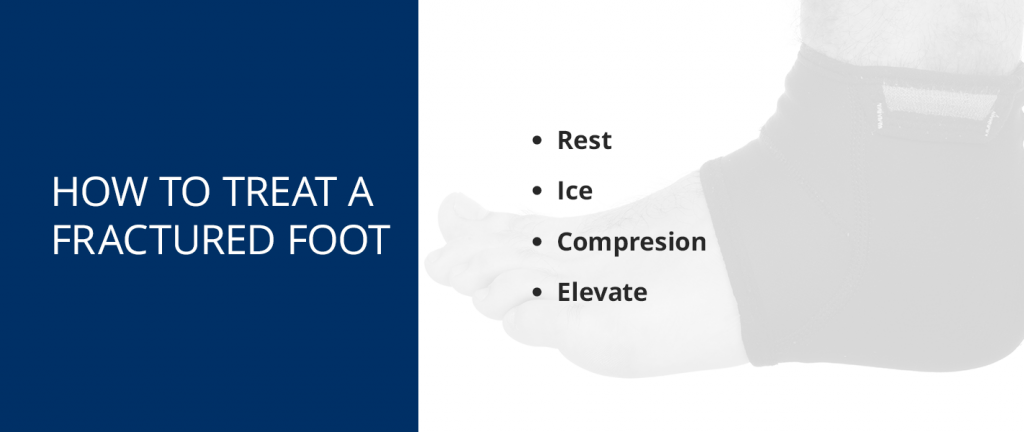
Acute injuries such as fractures, strains and top-of-the-foot sprains can occur in people of all ages. Anyone can experience a twisted ankle, which may cause intermittent, sharp pain on the top of the foot. Broken ankles, also called ankle fractures, occur quite frequently – especially in the winter when there is ice around. We are also seeing more broken ankles as people remain more active into their later years than they have in previous generations. Let’s look at how to identify each of these injuries, as well as treatment tips and options.
How Do You Determine Whether You Have a Fracture, Sprain or Strain?
Doctors determine whether you have a fracture, sprain or strain by assessing the type of tissue affected. A fracture is a break or crack in a hard bone, but detecting the difference between a sprain and strain is not straightforward. A sprain occurs when the ligament that attaches bones together is injured, while a strain is a tear in a tendon or muscle.
What Is a Fractured Foot?
A fractured foot is a break or crack in one or more of the bones in your foot. There are 26 bones in each of your feet, and they include:
- Phalanges: The phalanges consist of 14 bones in your toe. Your big toe contains two phalanges, while your second through fifth toes each contain three phalanges. Doctors call the different phalanges your proximal, middle and distal phalanges.
- Tarsal bones: The tarsal bones form your midfoot arch and connect your ankle and heel to the rest of your foot. The five different tarsal bones include your medial, intermediate and lateral cuneiforms and your cuboid and navicular bones.
- Metatarsal bones: Your metatarsal bones connect your tarsal bones to your phalanges. Each foot has five metatarsal bones.
- Talus: Your talus sits at the top of your foot, connecting your lower leg bones — tibia and fibula — to your foot. You may know it as your ankle bone.
- Calcaneus: Your calcaneus is your heel bone, located below the talus. It is the largest bone in your foot and supports your body weight.
Considering those bones, here are different types of foot fractures you may experience:
- Ankle fractures: The main bone of the ankle is the tibia. The bump on the inside of the ankle, called the medial malleolus, is part of the tibia. The smaller bone on the outside of the ankle is called the fibula and its bump is called the lateral malleolus. These two bones are held tightly together by a ligament called the syndesmosis. Between these two bones is the talus. Strong ligaments attach the medial and lateral malleoli to the talus. An ankle fracture is when a break occurs in your talus bone, lower tibia or lower fibula. These fractures often happen through twisting, rolling or turning motions when walking, running or playing sports. Trauma causes ankle fractures less often.
- Metatarsal bone fractures: Metatarsal fractures often occur due to trauma or repetitive stress. Thus, stress fractures — hairline crack due to repeated impact — are common with these bones. Metatarsal bones are also the most commonly fractured of all foot bones.
- Toe fractures: Toe fractures, involving your phalanges, occur due to trauma or repetitive microstress. They can either be cracked or broken cleanly. Common causes of toe fractures include overuse, leading to stress fractures, kicking something too hard or dropping a heavy object on your toe.
- Heel fractures: Heel fractures are uncommon. They represent approximately 1-2% of all adult fractures. High-impact is the most common cause of heel fractures, leading to either intra-articular or extra-articular fractures. Intra-articular fractures involve the joint, while extra-articular fractures do not.
What Is a Sprained Foot?
A sprained foot involves stretching or tearing the ligaments of your foot. Athletes and dancers commonly experience a sprained foot or ankle. Ligaments are strong bands of tissue that connect and stabilize your bones. In one foot, you have over 100 ligaments. The most commonly sprained ligaments in your foot and ankle are:
- Anterior talofibular ligament (ATFL): An ATFL sprain is one of the most common ankle sprains. Your ATFL ligament connects the front edge of your lower fibula to your talus bone. This sprain occurs when your center of gravity shifts over the outside of your leg, causing your ankle to roll inward. If serious enough, an ATFL sprain can also cause a sprain in your calcaneofibular ligament (CFL), located in your mid-ankle.
- Lisfranc ligaments: Your lisfranc ligaments form your midfoot, connecting your medial cuneiform bone to the second and third metatarsal bones. Thus, a torn or stretched lisfranc ligament is a midfoot sprain. Midfoot sprains often occur due to cutting or twisting maneuvers while you keep your foot planted.
- Collateral ligaments: Your collateral ligaments connect your phalanx bone in your big toe to your first metatarsal. They keep your big toe from moving too far on either side. When you tear or stretch these ligaments, it causes turf toe. This sprain often occurs when you bend your big toe upward too far. It has the name turf toe because 83% of these sprains occur on artificial turf.
What Is a Strained Foot?
A strained foot involves a stretched or torn tendon or muscle in your foot. Your feet have 19 intrinsic muscles and several tendons. Whereas muscles provide strength to your feet, tendons provide stability by connecting your muscles to your bones. The most common cause of foot strain is overuse, leading to tendonitis. However, stretched and torn muscles may occur from awkward movements.
What is a Fractured Ankle?
There are three main bones about the ankle. A broken ankle may involve any one of these bones or a combination. In general, the more bones that are involved the more severe the injury. If part of one of the bones is broken you may be able to still walk. But if more than one bone is involved the ankle is typically too unstable to support movement.
How Do You Know if You Have a Top of Foot Fracture, Sprain or Strain?
The symptoms of a foot sprain, fracture or strain are different for each type of injury. If you sprain the top of your foot, you may experience:
- Bruising.
- Deformity in your foot.
- Difficulty walking or bearing weight.
- Immediate, throbbing pain.
As for strains and sprains, here are a few signs that you may have a strain, sprain or top of foot injury:
- You experience pain, weakness or tenderness in the area around your foot or ankle.
- The injured part of your foot is bruised or swollen.
- You feel intense pain or numbness when you try to put weight on the affected foot.
- You feel cramps or your muscles tighten up on their own.
How Do You Know if You Have a Fractured Ankle?
A broken ankle can occur if you twist your foot awkwardly while walking, step on something slippery, or sustain an impact to your foot such as in a car accident or from a fall. It can be difficult to tell the difference between a bad ankle sprain or a broken ankle. Typical symptoms include pain with walking or the inability to walk or bear any weight at all. Signs of a broken ankle include swelling, bruising, tenderness to the touch or even deformity.
When Should You See an Orthopedic Doctor for a Foot Fracture, Sprain or Strain?
For a severe injury, you need to treat it as an emergency and see your doctor immediately. For less severe cases with minimal swelling and pain, you should apply home treatments first for a couple of days and then consult your physician if the pain persists. If you have a sports injury, you should consult your doctor for treatment right away.
Here are some signs of foot fractures, sprains or strains that require medical attention:
- You experience frequent pain weeks after your injury.
- You notice a deformity in your foot, toe or ankle.
- Your pain worsens or does not get better with time.
- Your swelling does not improve within two to five days after your injury.
You should go to the emergency room for a foot fracture, sprain or strain if you experience these symptoms:
- Inability to walk or put any weight on your foot
- Open wound or bones poking through the skin, also known as a compound fracture
What Should You Do If You Think You Have a Fractured Ankle?
It can be difficult to tell the difference between an ankle sprain and a fractured ankle. This is why you should be evaluated by a physician. The physician will likely order x-rays and in some cases further imaging studies such as a stress x-ray which is used to evaluate a syndesmosis injury, a CT scan, or an MRI.
Most ankle fractures can be treated without surgery, but some do require surgery to heal correctly. You and your doctor will discuss your treatment options to figure out what is best for your injury. You may be sent home in a temporary splint, a brace, boot or cast. Once you get home you should elevate your ankle to about the level of your heart when you are lying down. When sitting up you can prop it on pillows or an ottoman or table. If you do not have a very bulky dressing on you should apply ice or frozen peas for 20 minutes per hour allowing about 40 minutes between sessions to prevent burns. Never put ice directly on your skin – wrap it in a light towel or t-shirt. Make sure you understand your treatment plan, including whether or not you are allowed to put weight on your ankle, and schedule a time to follow up with your physician.
How to Treat a Fractured Foot

Before you visit your doctor to examine the injury, use the proven RICE therapy as top of foot pain treatment to reduce swelling:
- Rest: Don’t put any weight on your injured foot and pause all activities or exercise routines. If you’re wondering, “Can I walk on a fractured foot?” the answer to your question is no! Refrain from walking on your foot to promote healing.
- Ice: Apply ice to your injury for 15 to 20 minutes every three hours or so. You can use an ice pack or wrap a bag of frozen vegetables in a small towel and place it on your foot.
- Compression: Support your foot with a bandage. Doing so will also reduce swelling.
- Elevate: Raise your foot on a pillow to reduce fluid flow to the affected area.
You should also avoid taking hot baths or drinking alcoholic beverages for the first two days after the injury. You may use over-the-counter medication to reduce pain.
Besides RICE therapy, your doctor will also immobilize the area with a short walking boot, cast shoe, brace or elastic bandage. For a stress fracture, they may give you protective footwear and crutches to reduce stress on your foot.
Further treatment depends on whether the injury involves a displaced or non-displaced fracture. A displaced fracture occurs when a gap forms at the fracture site. A non-displaced fracture is a break that does not move the bone out of alignment. You can avoid surgery with non-displaced fractures most of the time, but displaced fractures often require surgery for the bone to heal as it should.
Can You Walk on a Fractured Foot?
The answer to the question, “Can you walk on a fractured foot?” differs from the question, “Should you walk on a fractured foot?” Many minor fractures do not prevent your ability to walk. Still, to speed up healing and prevent further injury, you should avoid bearing weight on the injury as much as possible. Your doctor may provide crutches so you can walk without bearing weight on your foot. With moderate to severe foot fractures, your foot will most likely lack all weight-bearing ability.
How to Treat a Sprained or Strained Foot
As with fractures, you should also use the RICE method to treat a fractured foot before you see a doctor. If you have a mild sprain or strain, the RICE method should provide sufficient treatment to let your injury heal. It is still a good idea to see a doctor about a mild sprain or strain in case your injury requires further care.
If your sprain or strain is moderate to severe, your doctor will immobilize your foot or ankle with a cast, brace or splint. The most severe foot sprains and strains require surgery. Whatever extra treatments your doctor provides, continue to use the RICE method to aid healing.
Can You Walk on a Sprained or Strained Foot?
Although it is possible to walk on some foot sprains and strains, you should refrain from doing so until your injury heals enough. Even though sprains on the top of your foot impact your walking ability less than those on the bottom, you should still prioritize rest. If your ligament, muscle or tendon is completely torn, you likely won’t be able to walk or bear any weight on it.
Top of Foot: Treatment Tips for Fracture, Sprain or Strain FAQ
Below are a couple of common questions we have received related to a top of foot fracture, sprain or strain.
What Type of Physical Therapy Is Needed for a Fracture, Sprain or Strain?
Not all fractures, sprains or strains require physical therapy. In most cases, exercises and basic joint movements can improve the speed of healing. Therapy is particularly useful when you experience weakness or stiffness in the area of the injury. Therapy also helps increase muscle strength and range of motion at the joint.
How Long Does It Take for a Sprained or Strained Foot to Recover?
Sprains and strains have a similar recovery timeframe as fractures. That said, minor to moderate sprains and strains heal faster than fractures — approximately two to four weeks. Sprains or strains that require immobilization take about six to eight weeks to heal, while those requiring surgery may take anywhere from three to six months to recover.
Meet Our Doctors Who Treat the Foot & Ankle
If you have a fracture, sprain, strain or intense pain in your foot, give us a call now. You can speak to one of our highly skilled orthopedic surgeons who will answer all your questions in a way that you can easily understand. We can’t wait to receive you and treat you like a member of our family.

